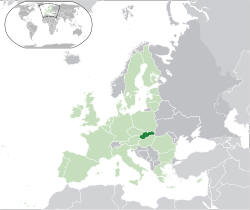|
|

List of Banks in Slovakia

The Slavs arrived in the territory of
present day Slovakia in the 5th and 6th centuries during the migration
period. In the course of history, various parts of today's Slovakia
belonged to Samo's Empire (the first known political unit of Slavs),
Principality of Nitra (as independent polity, as part of Great Moravia
and as part of Hungarian Kingdom), Great Moravia, Kingdom of Hungary,
the Austro-Hungarian Empire or Habsburg Empire, and Czechoslovakia. A
separate Slovak state briefly existed during World War II, during which
Slovakia was a dependency of Nazi Germany between 1939-1944. From 1945
Slovakia once again became a part of Czechoslovakia. The present-day
Slovakia became an independent state on 1 January 1993 after the
peaceful dissolution of Czechoslovakia.
Slovakia is a high-income advanced economy with one of the fastest
growth rates in the European Union and the OECD. The country joined
the European Union in 2004 and the Eurozone on 1 January 2009. Slovakia
together with Slovenia and Estonia are the only former Communist nations
to be part of the European Union, Eurozone, Schengen Area and NATO
simultaneously.
|
|
Central banks
Eximbanka SR
National Bank of Slovakia
Commercial and Savings Banks
Ceskoslovenska obchodna
banka, a. s.
CSOB stavebna sporitelna, a. s.
Dexia banka Slovensko a. s.
OTP Banka Slovensko, a. s.
Postova banka, a. s.
Privatbanka, a. s.
Prva stavebna sporitelna, a. s.
Slovenska sporitelna, a. s.
Slovenska zarucna a rozvojova banka, a. s.
Tatra banka, a. s.
UniCredit Bank Slovakia, a. s.
VOLKSBANK Slovensko, a. s.
Vseobecna uverova banka, a. s.
Wüstenrot stavebna sporitelna, a. s
http://www.nbs.sk/en/financial-market-supervision/banking-sector-supervision/List-of-credit-institutions
|
The Slovak economy is
considered an advanced economy, with the country dubbed the "Tatra Tiger".
Slovakia transformed from a centrally planned economy to a market-driven
economy. Major privatizations are nearly complete, the banking sector is
almost completely in private hands, and foreign investment has risen.
Slovakia has recently been characterized by sustained high economic
growth. In 2006, Slovakia achieved the highest growth of GDP (8.9%)
among the members of the OECD. The annual GDP growth in 2007 is
estimated at 10% with a record level of 14% reached in the fourth
quarter.[50] According to Eurostat data, Slovak PPS GDP per capita stood
at 72 percent of the EU average in 2008.
The financial districtUnemployment, peaking at 19.2% at the end of 1999,
decreased to 7.51% in October 2008 according to the Statistical Office
of the Slovak Republic.[52] In addition to economic growth, migration of
workers to other EU countries also contributed to this reduction.
According to Eurostat, which uses a calculation method different from
that of the Statistical Office of the Slovak Republic, the unemployment
rate is still the second highest after Spain in the EU-15 group, at
9.9%.
Inflation dropped from an average annual rate of 12.0% in 2000 to just
3.3% in 2002, the election year, but it rose again in 2003-2004 because
of rising labor costs and excess taxes. It reached 3.7% in 2005.
Slovakia adopted the Euro currency on 1 January 2009 as the 16th member
of the Eurozone. The euro in Slovakia was approved by the European
commission on 7 May 2008. The Slovak koruna was revalued on 28 May 2008
to 30.126 for 1 euro, which was also the exchange rate for the euro.
Slovakia is an attractive country for foreign investors mainly because
of its low wages, low tax rates and well educated labour force. In
recent years, Slovakia has been pursuing a policy of encouraging foreign
investment. FDI inflow grew more than 600% from 2000 and cumulatively
reached an all-time high of $17.3 billion USD in 2006, or around $22,000
per capita by the end of 2008.
Slovakia joined the Eurozone in 2009Despite a sufficient number of
researchers and a decent secondary educational
system, Slovakia, along with other post-communist
countries, still faces major challenges in the field of the knowledge
economy. The business and public research and development expenditures
are well below the EU average. The Programme for International Student
Assessment, coordinated by the OECD, currently ranks Slovak secondary
education the 30th in the world (placing it just below the United States
and just above Spain).
In March 2008, the Ministry of Finance announced that Slovakia's economy
is developed enough to stop being an aid receiver from the World Bank.
Slovakia became an aid provider at the end of 2008
|


